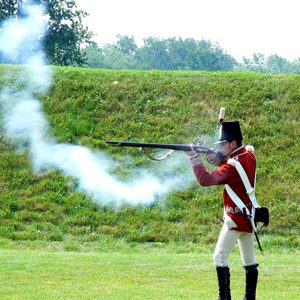That Time Oscar Wilde Came to Woodstock, Ontario

Looking back on an eventful local visit by the famed playwright and master of wit.
I am a lifelong resident and historian of Tillsonburg, Ontario. It is said that Mary Ann Tillson, the wife of Tillsonburg’s first mayor and founding family, attended a lecture by Oscar Wilde in Woodstock, Ontario, on May 29, 1882. For me, this was an incredible connection between our town’s history and the world-renowned playwright and late-Victorian caricature of flamboyance and wit.
Oscar Wilde travelled across North America for the full year of 1882. In the late spring he journeyed to Canada and had a number of speaking engagements through Ontario.
Arriving in Quebec, he spoke two nights in Montreal and one night in Quebec City. He began his Ontario excursion in Ottawa, moved west to Kingston and Belleville, then Toronto, Brantford and Woodstock, finishing in Hamilton before returning to the United States. He came back to Canada in October that year and graced the Maritime provinces with his presence.
Wilde spoke on the second floor opera house stage in the Woodstock Town Hall. Reporting the event on June 2, 1882, the Woodstock Sentinel-Review stated: “Oscar Wilde, the boss showman of the day, made a great impression here on Monday night.”
Today the building is the Woodstock Museum National Historic Site. Knowing this, when I meandered through the second floor of the museum, I came upon the stage in awe. The room has changed greatly since he honoured the space and is now utilized as a community/work room. The nostalgia of this little-known historical gem is not lost on those who stand there, aware that Oscar Wilde had once stood there, too.
Interestingly, the hotel where Wilde spent his night in Woodstock, the O’Neill House (later the Oxford Hotel), is still standing just across the road from the museum. Sadly, many of the opera houses in the other cities where he visited through Ontario have been demolished, removing a tangible glimpse and connection to Wilde from their communities.
But, in this museum’s multi-purpose room, nearly 140 years ago, Oscar Wilde pontificated on the evolution of modern culture, fashion and decorative arts. Borrowing from the contemporary Arts and Crafts Movement he promoted the usage of handcrafted furnishings. Patrons were encouraged to employ local craftspeople and use local materials. This was a reaction to the artificiality of mass production of the late industrial age.

A New Way Forward
There was a growing rejection to the dark and stuffy, cluttered curtained rooms of the mid- to late-Victorian home. Wilde would become famous for modernizing art initiatives and theories towards the Aesthetic Art Movement. This type of design and decoration was based on local trades, geometrics (which would later connect with the Art Deco period), images and interpretations of flora and fauna. These could be accomplished by incorporating organic looking carpentry, metal work and stained glass into the home.
These applications are seen in the design and decoration of Annandale House in Tillsonburg. Built in 1880 by Edwin Delevan and Mary Ann Tillson, it served as their stately home for retirement. The house was designated a National Historic Site in 1997. Its designation was based on it being one of the best surviving examples of a personal residence in Canada using the principles of the Aesthetic Movement. Having lived near and worked in Annandale NHS, I have had the opportunity to explore, research and experience the beauty of its aesthetic interior.
The Aesthetics Movement touted that beauty should be seen wherever you look. Homes should be bright and with evidence of nature’s splendour on the inside of the home. The Tillsons employed these properties into their magnificent home. The exterior of the house is made up of polished blonde brick from the Tillson brickyard. The front hall uses local wood with varying hues creating unique geometric patterns. Images of flowers and birds adorn the ceilings of the dining room, parlour and library. You can look straight up from the grand staircase and see the painted parrot on the third floor ceiling. And, as an homage to Wilde and his favourite flower, you can find images of sunflowers often.
Wilde’s legacy has grown over the years but the memory of his appearances in North America, particularly in Canada, have been largely forgotten. Tillsonburg and Woodstock have direct connections to the man and his influence on art and culture. It is a pleasure for this historian to introduce you to accessible locations that you too can discover, associated with Oscar Wilde, in small-town Ontario.
Next, take a virtual tour of the most famous houses in every province.






